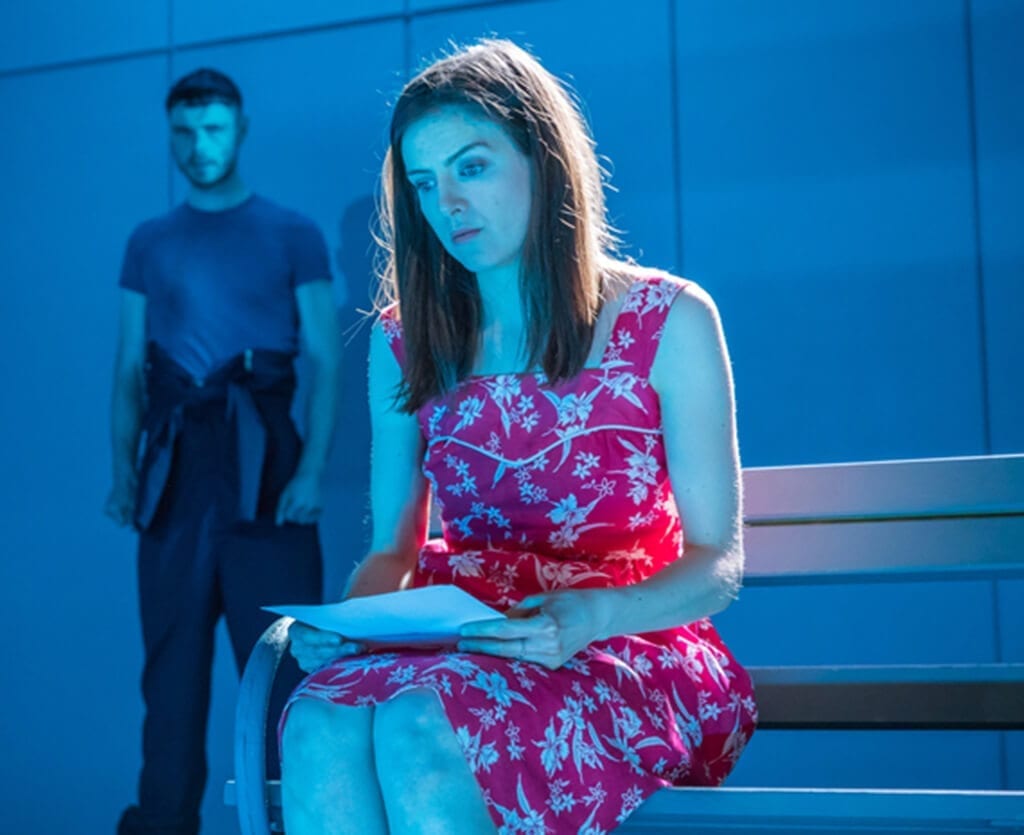Martin Crimp’s rarely performed play, The Treatment, is about a young woman called Anne who responds to an advert put out by two ‘facilitators’ (ostensibly film producers) looking to capture an experience of something authentic. They’re interested in Anne’s life story: and in particular how she is trapped in an abusive relationship with a man called Simon. This is complicated by Anne’s insistence that her descriptions of him as abusive are figurative (the knife he has threatened her with ‘isn’t visible’). The thing that is most torturous about living with him, she explains, isn’t that he’s abusive in a literal sense, but that he’s ‘profoundly ordinary’. In their pursuit of a compelling narrative, producers Andrew and Jennifer overlook this – and bring in a washed-up writer and a famous actor to add more overtly disturbing elements to an otherwise mundane narrative. Andrew tells Anne ‘once you’ve come to us with your story, your story is also ours’.
Crimp’s play is an exploration not just of the culture industry, but of the wider tendencies that it reflects. The theme of consumption pervades – be it the playwright Clifford’s voyeurism, or Andrew and Jennifer’s devotion to sashimi. There’s an obvious link between the uncontrollable appetites of these characters and Andrew and Jennifer’s hunger for salacious and morbid drama. Crimp’s inference seems to be that trapped in the vortex of consumerist society, we seek artificial experiences to fill the voids we have created. It’s a play about our complicity in this process: Anne, who comes across as clearly rootless and lost, is ultimately just an invested in manufacturing lies about her life as Andrew and Jennifer are, as some form of compensation for a pervasive sense of meaninglessness – even if a part of her resists this exploitative process. Adding a metafictional dimension, Crimp also suggests that we, the audience, are guilty of this complicity. As Anne’s partner Simon at one point observes: theatres are full of people who have paid ‘good money’ to be told that ‘the world is a heap of shit’.
It’s a brilliant play, and one that remains as relevant today as when it was first performed in 1993. Unfortunately Lyndsey Turner’s production doesn’t do a great deal to bring these themes to the fore. There are two fundamental issues…
The first is a stylistic one: primarily that the Lynchian, ersatz tone of the performances is, simply put, too crude an assertion of the characters’ fakeness. This not only makes the production feel flat – it also kind of misses the point. A bunch of Baudrillard quotes are bandied about in the programme notes – which is apt, as he’s the go-to critical theorist if you’re exploring the late-capitalist phenomenon of substituting our own lives with simulated realities (so blatantly exemplified by the entertainment industry). But here’s the rub: at the heart of Baudrillard’s analysis is the idea that the ‘hyperrealism of simulation’ has a ‘hallucinatory resemblance to the real itself’: that’s how it gets away with substituting and corrupting our lives without us ever really noticing… Conversely, the cast in Lyndsey Turner’s production behave like automatons: there’s no illusion of authenticity (or the ‘real’) but instead their fakeness is in plain sight, for all to see. Which makes the play feel didactic, as well as unrepresentative of the cultural phenomenon its reflecting. Crimp’s play itself does something far more unsettling, and also more reflective of the phenomenon that fascinated Baudrillard: the artifice is subtextual. The clue, really, is in the language: Crimp’s writing style, on the page, is closer to Mamet than it is to Churchill. It demands of any production complicity in the manufacturing of authenticity – not that its artifice be howlingly overt… Lyndsey Turner’s production doesn’t trust Crimp’s play to exhibit these themes, and instead forces them upon us. The result is we’re presented with an exaggerated and unrepresentative model of an existing cultural phenomenon, rather than being encouraged to deduce it from something both more subtle and more true-to-life.
The second issue is that Simon is presented in a manner that confirms Andrew and Jennifer’s description of him as abusive and weird. I can entirely understand why there’s a reluctance to redeem a male character who is described by his partner as abusive. In any other play, to do so would be verging on criminal. But this play simply doesn’t make sense if Simon is straightforwardly the malevolent archetype that Andrew and Jennifer make him out to be. He has to carry some of the profound ordinariness from Anne’s description of him for the manner of their misrepresentation to become clear – otherwise, the play really ceases to mean anything… It becomes an exercise in cheap surrealism, in fact. It’s plain to see, from the text, that it is Anne who encourages Simon to conform to her idea of him as abusive (by stabbing Clifford in the eyes) and in the final scene – in which Andrew attempts to rescue her from Simon – that Anne has simulated the circumstance of her abuse (she expresses amazement that the door has been left open, claiming that it’s made out of steel and is always locked…). In this production, Simon is presented in a way that ignores these crucial caveats – instead taking his behaviour in these key moments as indicative of the fact that he is some weird, abusive and (to be frank) classist stereotype. It may not sit comfortably with how we want to see women represented on stage (and I am sympathetic to the view that Crimp’s play trivialises domestic abuse) – but it seems obvious to me that the theme that he is exploring in the character of Anne is our complicity in the manufacturing of alternate realities, and how so many of us are tempted into this in an attempt to add colour to otherwise colourless and humdrum lives. By presenting her as an actual victim in an abusive relationship – which in both the design and the acting choices Lyndsey Turner’s production appears to do – it requires the audience to look beyond the production to make any of this out…
Unfortunately these two issues leave this production feeling more than a little confused. Oddly, it makes the point Crimp is trying to make about our psychological estrangement stylistically – through acting and design choices – whilst obfuscating the way in which in Crimp’s play itself conveys this through narrative. Which ultimately makes Crimp’s argument seem crude and unconvincing.
Still though, it has a lot to commend it as a production. Though I had issues with her wider choices: Lyndsey Turner’s text work is always resoundingly clear. And Giles Cadle’s design works well to conjure the effect of a Charlie Kaufman style sterilised and clinical environment (even if that choice feels like the wrong choice…). The performances are strong all round. Aisling Loftus is a really engaging performer to watch, and Ben Onwukwe is brilliant. But nothing can mask the fact that the fundamental decisions at the heart of this production obscure and complicate Crimp’s purpose…




